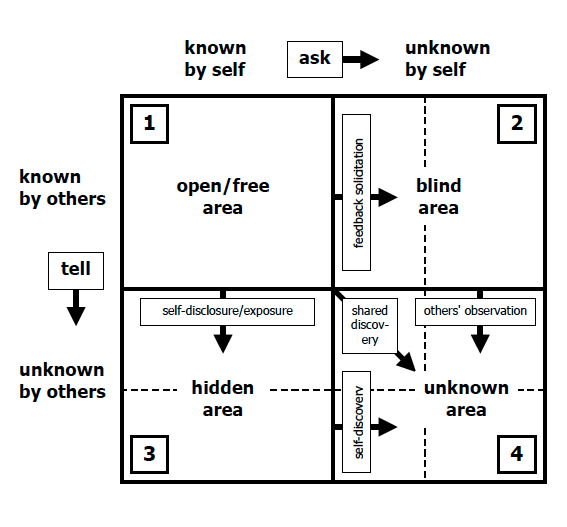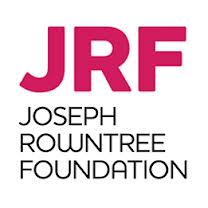In this post, Chris Bruce (Improvement Hub) reflects on the processes used by Iriss to gain a partner in this project. He presents an interesting perspective that was consistent with some members of the Critical Friend group, although direct contrast to others. Further reflections from the Iriss team are presented in a future post.
______
In the Pioneer Enabling Collaborative Leadership work, we have been thinking again about Johari’s window. This is a helpful model for thinking about feedback, and learning about ourselves from the perspectives of others. With its emphasis on the known and the unknown facets of ourselves, the model seeks to promote a way of being that maximises our own potential. The idea is that the more we can come to know ourselves, and minimise the “unknown” elements – the more effective and powerful we will be.
Image © alan chapman 2003
IRISS’ brave “big idea” led us as a group of critical friends to reflect together on the right use of power in exercising IRISS’ responsibilities. The organisation seeks to promote innovation and the use of evidence towards the public good of “improving personal outcomes that matter to people”. We found that ultimate purpose a helpful touchstone in supporting IRISS to think about what it should do and how it should do it.
I think that through these discussions every one of us [the Critical Friends group] has come to recognise how we habitually deploy our powers without realising we are doing so – and so often reinforce the status quo as we do this. In that vein, the IRISS team initially issued an invitation to partnerships to put forward proposals for work with IRISS – which would then be judged by the IRISS Team with a winner declared in due course. I guess the assumption was that IRISS would come up with an appropriate and transparent set of criteria for making the selection. Perhaps a fine example of Good Practice – under our current paradigms.
But the frame provided by the report of the Christie Commission, and the Self Directed Support legislation, and the focus on improving personal outcomes embedded in the Public Bodies (Joint Working) Act, gave us pause for thought. If we sought to promote co-production, genuinely seeing and recognising what each partner brought to the table, what gave one party the right to judge the others? So the (much more challenging) path of jointly deciding who should work with IRISS was chosen (and is written about elsewhere on this site).
Of course these processes mirror the work with people and their families that health and care workers do every day – trying to balance the wishes and wants of people, families, professionals, and agencies, to agree a plan that best suits everyone, makes use of everyone’s assets, builds communities and avoids unnecessary dependency on services. That practise of collaboration – which we can only achieve through good conversations – is mirrored in the conversations the IRISS team has had with the partnerships.
It is only by practising what we preach – enacting our policies – adopting an appropriate way of being – that we can best use our selves to add to the public good. Our unknown selves have great potential for good – our known selves can be challenged and built on if we deliberately suspend our habitual behaviours and try new habits. IRISS have modelled this approach in this first phase of the Big Idea. The approach has drawn in all of the interested parties, sought their input as equal thinking partners, and been brought to an initial conclusion, all by mutual consent. It has been painful at times, with raw emotion in the room and afterwards. People have discovered things about themselves that they didn’t know before.
We can be confident that this will have a significant impact on what comes next, as a certain tone has been set from the beginning.
We also believe that one or two of the partnerships not selected to work with IRISS will progress their proposals “anyway” and I have no doubt that IRISS will want to help and follow developments as far as resources allow. I think we can say at this stage that a longer process, deliberately attempting to include all interested partners, has led to greater learning, a good output, and some positive spin-offs. What’s not to like?


